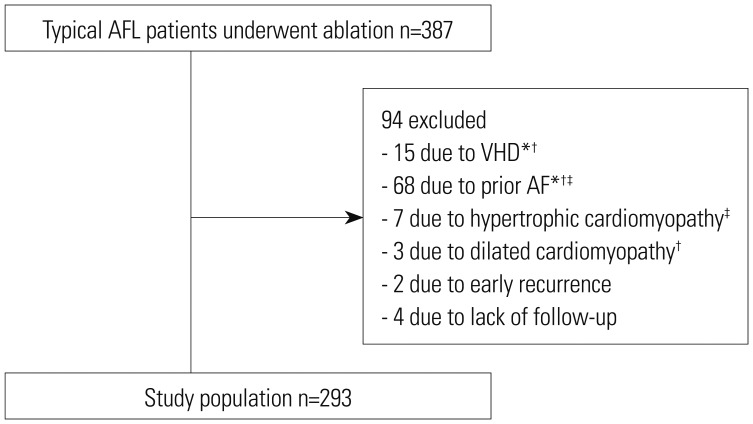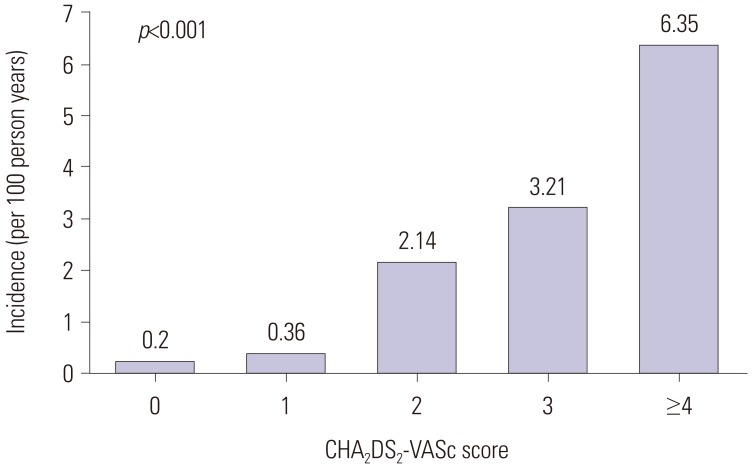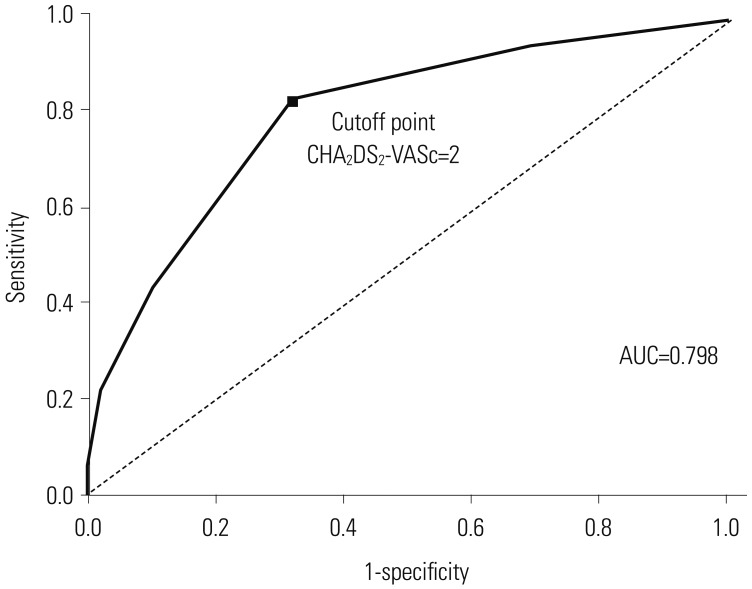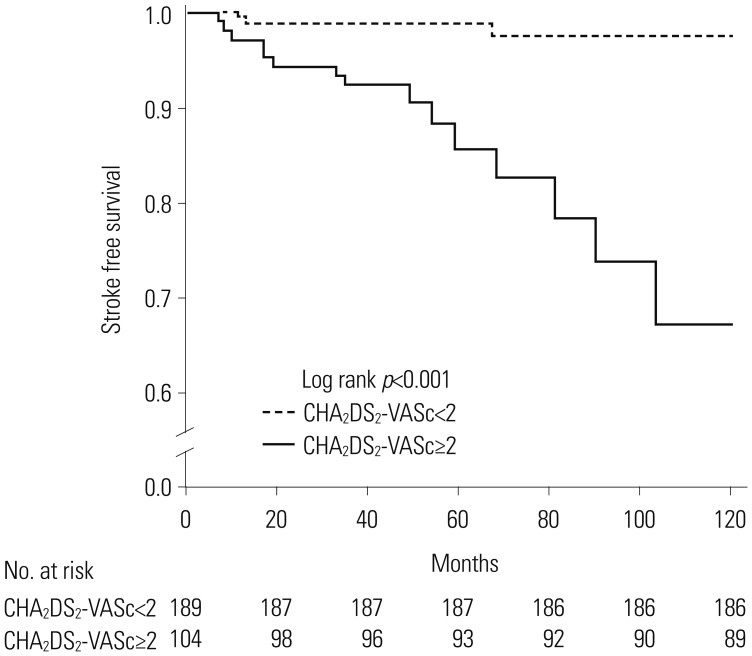Yonsei Med J.
2018 Mar;59(2):236-242. 10.3349/ymj.2018.59.2.236.
CHAâ‚‚DSâ‚‚-VASc Score in the Prediction of Ischemic Stroke in Patients after Radiofrequency Catheter Ablation of Typical Atrial Flutter
- Affiliations
-
- 1Division of Cardiology, Severance Cardiovascular Hospital, Yonsei University College of Medicine, Seoul, Korea. cby6908@yuhs.ac
- KMID: 2418786
- DOI: http://doi.org/10.3349/ymj.2018.59.2.236
Abstract
- PURPOSE
Despite undergoing successful catheter ablation of typical atrial flutter (AFL), patients remain at increased risk for ischemic stroke. However, data on risk prediction tools for the development of stroke after AFL ablation are lacking. This study investigates whether CHAâ‚‚DSâ‚‚-VASc score is useful for predicting ischemic stroke after successful ablation of typical AFL.
MATERIALS AND METHODS
A total of 293 patients (236 men, mean age 56.1±13.5 years) who underwent successful radiofrequency catheter ablation for typical AFL were included in this study. The clinical end point was occurrence of ischemic stroke during follow-up after AFL ablation.
RESULTS
During the follow-up period (60.8±45.9 months), ischemic stroke occurred in 18 (6%) patients at a median of 34 months (interquartile range, 13-65 months). CHAâ‚‚DSâ‚‚-VASc score [hazard ratio 2.104; 95% confidence interval (CI), 1.624-2.726; p < 0.001] was an independent predictor for the occurrence of stroke after AFL ablation. The area under the receiver operating characteristic curve for CHAâ‚‚DSâ‚‚-VASc score was 0.798 (95% CI, 0.691-0.904). The CHAâ‚‚DSâ‚‚-VASc score could be used to stratify patients into two groups with different incidences of ischemic stroke (1.6% vs. 14.4%, p < 0.001) at a cutoff value of 2.
CONCLUSION
CHAâ‚‚DSâ‚‚-VASc score is useful in a prediction model for the risk of stroke after catheter ablation of typical AFL.
MeSH Terms
-
Aged
Aged, 80 and over
Atrial Flutter/*surgery
Brain Ischemia/epidemiology/*etiology
Catheter Ablation/*adverse effects
Female
Follow-Up Studies
Humans
Incidence
Middle Aged
Postoperative Complications/*epidemiology
Predictive Value of Tests
Prognosis
Proportional Hazards Models
ROC Curve
Risk Assessment/*methods
Seoul/epidemiology
Stroke/epidemiology/*etiology
Treatment Outcome
Figure
Reference
-
1. Halligan SC, Gersh BJ, Brown RD Jr, Rosales AG, Munger TM, Shen WK, et al. The natural history of lone atrial flutter. Ann Intern Med. 2004; 140:265–268. PMID: 14970149.
Article2. Biblo LA, Yuan Z, Quan KJ, Mackall JA, Rimm AA. Risk of stroke in patients with atrial flutter. Am J Cardiol. 2001; 87:346–349. PMID: 11165976.
Article3. Verma A, Macle L, Cox J, Skanes AC. CCS Atrial Fibrillation Guidelines Committee. Canadian Cardiovascular Society atrial fibrillation guidelines 2010: catheter ablation for atrial fibrillation/atrial flutter. Can J Cardiol. 2011; 27:60–66. PMID: 21329863.
Article4. Pérez FJ, Schubert CM, Parvez B, Pathak V, Ellenbogen KA, Wood MA. Long-term outcomes after catheter ablation of cavo-tricuspid isthmus dependent atrial flutter: a meta-analysis. Circ Arrhythm Electrophysiol. 2009; 2:393–401. PMID: 19808495.5. Chinitz JS, Gerstenfeld EP, Marchlinski FE, Callans DJ. Atrial fibrillation is common after ablation of isolated atrial flutter during long-term follow-up. Heart Rhythm. 2007; 4:1029–1033. PMID: 17675077.
Article6. Dixit S, Lavi N, Robinson M, Riley MP, Callans DJ, Marchlinski FE, et al. Noncontact electroanatomic mapping to characterize typical atrial flutter: participation of right atrial posterior wall in the reentrant circuit. J Cardiovasc Electrophysiol. 2011; 22:422–430. PMID: 20958830.
Article7. Tomson TT, Kapa S, Bala R, Riley MP, Lin D, Epstein AE, et al. Risk of stroke and atrial fibrillation after radiofrequency catheter ablation of typical atrial flutter. Heart Rhythm. 2012; 9:1779–1784. PMID: 22813577.
Article8. Moubarak G, Pavin D, Donal E, Laviolle B, Daubert JC, Mabo P. Ischemic strokes after ablation of typical atrial flutter. Int J Cardiol. 2011; 147:183–184. PMID: 21190746.
Article9. Tai CT, Chen SA, Chiang CE, Lee SH, Wen ZC, Huang JL, et al. Long-term outcome of radiofrequency catheter ablation for typical atrial flutter: risk prediction of recurrent arrhythmias. J Cardiovasc Electrophysiol. 1998; 9:115–121. PMID: 9511885.10. Movsowitz C, Callans DJ, Schwartzman D, Gottlieb C, Marchlinski FE. The results of atrial flutter ablation in patients with and without a history of atrial fibrillation. Am J Cardiol. 1996; 78:93–96. PMID: 8712128.
Article11. January CT, Wann LS, Alpert JS, Calkins H, Cigarroa JE, Cleveland JC Jr, et al. 2014 AHA/ACC/HRS guideline for the management of patients with atrial fibrillation: a report of the American College of Cardiology/American Heart Association Task Force on Practice Guidelines and the Heart Rhythm Society. J Am Coll Cardiol. 2014; 64:e1–e76. PMID: 24685669.12. Calkins H, Kuck KH, Cappato R, Brugada J, Camm AJ, Chen SA, et al. 2012 HRS/EHRA/ECAS expert consensus statement on catheter and surgical ablation of atrial fibrillation: recommendations for patient selection, procedural techniques, patient management and follow-up, definitions, endpoints, and research trial design: a report of the Heart Rhythm Society (HRS) Task Force on Catheter and Surgical Ablation of Atrial Fibrillation. Developed in partnership with the European Heart Rhythm Association (EHRA), a registered branch of the European Society of Cardiology (ESC) and the European Cardiac Arrhythmia Society (ECAS); and in collaboration with the American College of Cardiology (ACC), American Heart Association (AHA), the Asia Pacific Heart Rhythm Society (APHRS), and the Society of Thoracic Surgeons (STS). Endorsed by the governing bodies of the American College of Cardiology Foundation, the American Heart Association, the European Cardiac Arrhythmia Society, the European Heart Rhythm Association, the Society of Thoracic Surgeons, the Asia Pacific Heart Rhythm Society, and the Heart Rhythm Society. Heart Rhythm. 2012; 9:632–696. PMID: 22386883.13. Goldstein LB, Bertels C, Davis JN. Interrater reliability of the NIH stroke scale. Arch Neurol. 1989; 46:660–662. PMID: 2730378.
Article14. Adams HP Jr, Bendixen BH, Kappelle LJ, Biller J, Love BB, Gordon DL, et al. Classification of subtype of acute ischemic stroke. Definitions for use in a multicenter clinical trial. TOAST. Trial of Org 10172 in Acute Stroke Treatment. Stroke. 1993; 24:35–41. PMID: 7678184.
Article15. Lip GY, Nieuwlaat R, Pisters R, Lane DA, Crijns HJ. Refining clinical risk stratification for predicting stroke and thromboembolism in atrial fibrillation using a novel risk factor-based approach: the euro heart survey on atrial fibrillation. Chest. 2010; 137:263–272. PMID: 19762550.16. Olesen JB, Lip GY, Hansen ML, Hansen PR, Tolstrup JS, Lindhardsen J, et al. Validation of risk stratification schemes for predicting stroke and thromboembolism in patients with atrial fibrillation: nationwide cohort study. BMJ. 2011; 342:d124. PMID: 21282258.
Article17. Friberg L, Rosenqvist M, Lip GY. Evaluation of risk stratification schemes for ischaemic stroke and bleeding in 182 678 patients with atrial fibrillation: the Swedish Atrial Fibrillation cohort study. Eur Heart J. 2012; 33:1500–1510. PMID: 22246443.
Article18. Camm AJ, Lip GY, De Caterina R, Savelieva I, Atar D, Hohnloser SH, et al. 2012 focused update of the ESC Guidelines for the management of atrial fibrillation: an update of the 2010 ESC Guidelines for the management of atrial fibrillation. Developed with the special contribution of the European Heart Rhythm Association. Eur Heart J. 2012; 33:2719–2747. PMID: 22922413.19. Chao TF, Lin YJ, Tsao HM, Tsai CF, Lin WS, Chang SL, et al. CHADS(2) and CHA(2)DS(2)-VASc scores in the prediction of clinical outcomes in patients with atrial fibrillation after catheter ablation. J Am Coll Cardiol. 2011; 58:2380–2385. PMID: 22115643.
Article20. Mitchell LB, Southern DA, Galbraith D, Ghali WA, Knudtson M, Wilton SB. Prediction of stroke or TIA in patients without atrial fibrillation using CHADS2 and CHA2DS2-VASc scores. Heart. 2014; 100:1524–1530. PMID: 24860007.21. Parikh MG, Aziz Z, Krishnan K, Madias C, Trohman RG. Usefulness of transesophageal echocardiography to confirm clinical utility of CHA2DS2-VASc and CHADS2 scores in atrial flutter. Am J Cardiol. 2012; 109:550–555. PMID: 22133753.
Article22. Ohira T, Shahar E, Chambless LE, Rosamond WD, Mosley TH Jr, Folsom AR. Risk factors for ischemic stroke subtypes: the Atherosclerosis Risk in Communities study. Stroke. 2006; 37:2493–2498. PMID: 16931783.23. Lip GY, Ponikowski P, Andreotti F, Anker SD, Filippatos G, Homma S, et al. Thrombo-embolism and antithrombotic therapy for heart failure in sinus rhythm. A joint consensus document from the ESC Heart Failure Association and the ESC Working Group on Thrombosis. Eur J Heart Fail. 2012; 14:681–695. PMID: 22611046.
Article24. Melgaard L, Gorst-Rasmussen A, Lane DA, Rasmussen LH, Larsen TB, Lip GY. Assessment of the CHA2DS2-VASc score in predicting ischemic stroke, thromboembolism, and death in patients with heart failure with and without atrial fibrillation. JAMA. 2015; 314:1030–1038. PMID: 26318604.
Article25. Jacobs V, May HT, Bair TL, Crandall BG, Cutler M, Day JD, et al. The impact of risk score (CHADS2 versus CHA2DS2-VASc) on long-term outcomes after atrial fibrillation ablation. Heart Rhythm. 2015; 12:681–686. PMID: 25546809.
Article26. Spector P, Reynolds MR, Calkins H, Sondhi M, Xu Y, Martin A, et al. Meta-analysis of ablation of atrial flutter and supraventricular tachycardia. Am J Cardiol. 2009; 104:671–677. PMID: 19699343.27. Seara JG, Roubin SR, Gude Sampedro F, Barreiro VB, Sande JM, Mañero MR, et al. Risk of atrial fibrillation, stroke, and death after radiofrequency catheter ablation of typical atrial flutter. Clin Res Cardiol. 2014; 103:543–552. PMID: 24566731.
Article28. Wood KA, Eisenberg SJ, Kalman JM, Drew BJ, Saxon LA, Lee RJ, et al. Risk of thromboembolism in chronic atrial flutter. Am J Cardiol. 1997; 79:1043–1047. PMID: 9114761.
Article29. Carandang R, Seshadri S, Beiser A, Kelly-Hayes M, Kase CS, Kannel WB, et al. Trends in incidence, lifetime risk, severity, and 30-day mortality of stroke over the past 50 years. JAMA. 2006; 296:2939–2946. PMID: 17190894.
Article30. Eckman MH, Singer DE, Rosand J, Greenberg SM. Moving the tipping point: the decision to anticoagulate patients with atrial fibrillation. Circ Cardiovasc Qual Outcomes. 2011; 4:14–21. PMID: 21139092.
- Full Text Links
- Actions
-
Cited
- CITED
-
- Close
- Share
- Similar articles
-
- The Impact of the CHAâ‚‚DSâ‚‚-VASc Score on Recurrence of Atrial Fibrillation after a Single Catheter Ablation and Atrial Remodeling in Patients with Non-Valvular Atrial Fibrillation
- Management of Atrial Flutter
- Stroke Prevention in Atrial Fibrillation
- A Thin Left Atrial Antral Wall Around the Pulmonary Vein Reflects Structural Remodeling by Atrial Fibrillation and is Associated with Stroke
- Catheter Ablation of Atrial Flutter Using Radiofrequency Energy in a Child: A Case Report





